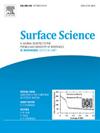Pt33纳米颗粒的支持依赖性调制:氧相互作用,稳定性,电子性质和几何结构的见解
IF 2.1
4区 化学
Q3 CHEMISTRY, PHYSICAL
引用次数: 0
摘要
了解支撑材料如何影响Pt纳米颗粒的性质对于推进催化剂的开发至关重要。利用密度泛函理论计算,我们研究了石墨烯、MgO(100)、α-Al2O3(0001)和SnO2(110)载体对O原子吸附以及Pt33纳米粒子的稳定性、电子和几何性质的影响。我们的研究结果表明,所有载体都显著增强了Pt33/载体界面上O原子的吸附,对Pt原子的剥离和纳米颗粒的稳定性有不同的影响。pt -支撑相互作用的强度顺序为:石墨烯<;分别以(100)& lt;α氧化铝(0001)& lt;SnO2(110)。键序分析表明,载体稳定了Pt33及其外层原子中的Pt-Pt相互作用。Pt33和载体之间的电子平衡导致电子从石墨烯、MgO(100)和α-Al2O3(0001)转移到Pt33,从Pt33转移到SnO2(110),移动d带中心并影响催化性能。应变分析揭示了压缩和拉伸对Pt-Pt距离的影响,与Pt33吸附能相关,表明几何变化与纳米颗粒稳定性之间存在联系。这些见解阐明了载体在O原子吸附机制和Pt纳米颗粒性质调整中的作用,为设计具有更高效率和稳定性的先进催化剂提供了有价值的指导,可用于燃料电池、传感器和环境修复。本文章由计算机程序翻译,如有差异,请以英文原文为准。

Support-dependent modulation of Pt33 nanoparticles: Insights into oxygen interaction, stability, electronic properties, and geometric structure
Understanding how support materials influence the properties of Pt nanoparticles is crucial for advancing catalyst development. Using density functional theory calculations, we examine the effects of graphene, MgO(100), α-Al2O3(0001), and SnO2(110) supports on O atom adsorption and the stability, electronic, and geometric properties of Pt33 nanoparticles. Our findings reveal that all supports significantly enhance O atom adsorption at the Pt33/support interface, with varying implications for Pt atom detachment and nanoparticle stability. The strength of Pt–support interactions follows the order: graphene < MgO(100) < α-Al2O3(0001) < SnO2(110). Bond order analysis indicates that supports stabilize the Pt–Pt interactions in the supported Pt33 and their outer shell atoms. Electronic equilibrium between Pt33 and the support induces electron transfer from graphene, MgO(100), and α-Al2O3(0001) to Pt33, and from Pt33 to SnO2(110), shifting the d-band center and influencing catalytic properties. Strain analysis reveals compressive and tensile effects on Pt–Pt distances, correlating with the Pt33 adsorption energies and indicating a link between geometric changes and nanoparticle stability. These insights elucidate the role of supports in O atom adsorption mechanisms and the tuning of Pt nanoparticle properties, providing valuable guidance for designing advanced catalysts with enhanced efficiency and stability for applications in fuel cells, sensors, and environmental remediation.
求助全文
通过发布文献求助,成功后即可免费获取论文全文。
去求助
来源期刊

Surface Science
化学-物理:凝聚态物理
CiteScore
3.30
自引率
5.30%
发文量
137
审稿时长
25 days
期刊介绍:
Surface Science is devoted to elucidating the fundamental aspects of chemistry and physics occurring at a wide range of surfaces and interfaces and to disseminating this knowledge fast. The journal welcomes a broad spectrum of topics, including but not limited to:
• model systems (e.g. in Ultra High Vacuum) under well-controlled reactive conditions
• nanoscale science and engineering, including manipulation of matter at the atomic/molecular scale and assembly phenomena
• reactivity of surfaces as related to various applied areas including heterogeneous catalysis, chemistry at electrified interfaces, and semiconductors functionalization
• phenomena at interfaces relevant to energy storage and conversion, and fuels production and utilization
• surface reactivity for environmental protection and pollution remediation
• interactions at surfaces of soft matter, including polymers and biomaterials.
Both experimental and theoretical work, including modeling, is within the scope of the journal. Work published in Surface Science reaches a wide readership, from chemistry and physics to biology and materials science and engineering, providing an excellent forum for cross-fertilization of ideas and broad dissemination of scientific discoveries.
 求助内容:
求助内容: 应助结果提醒方式:
应助结果提醒方式:


